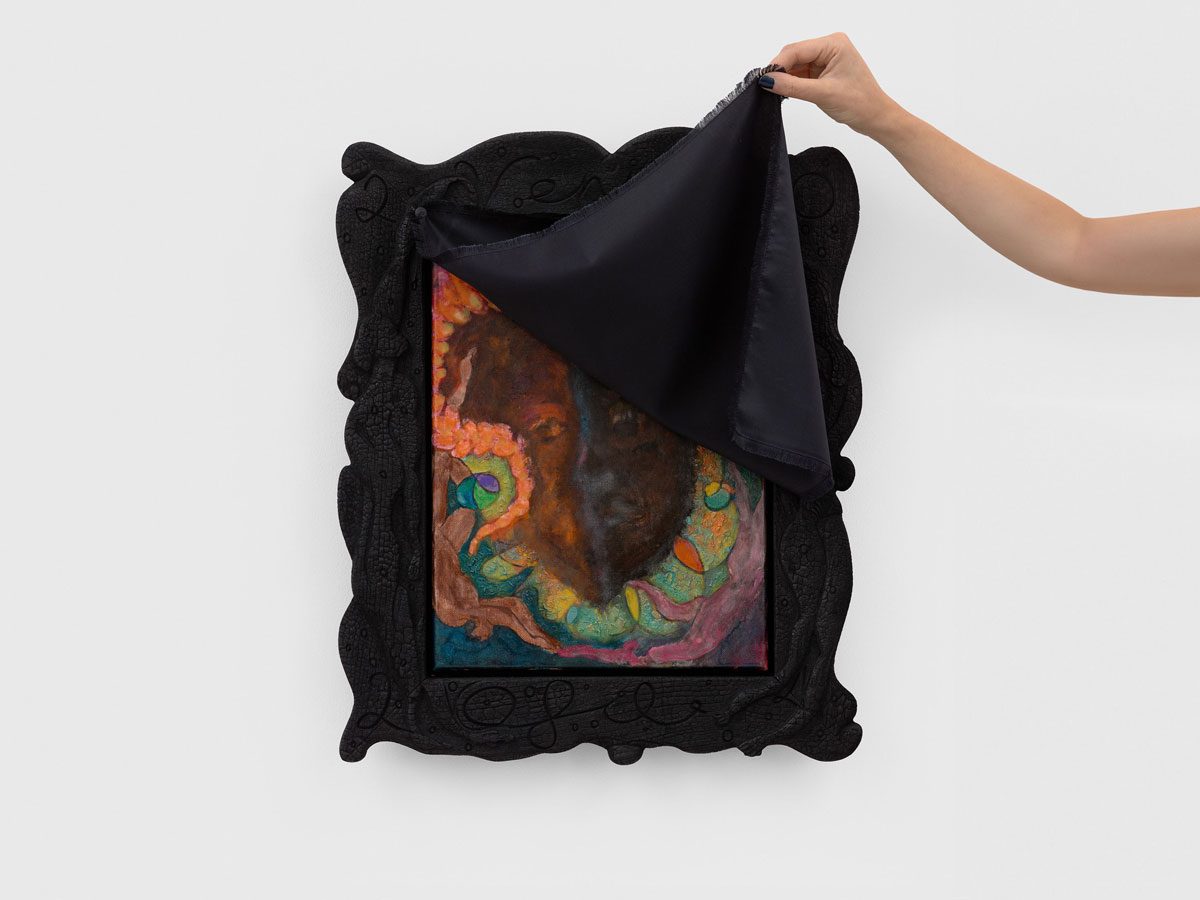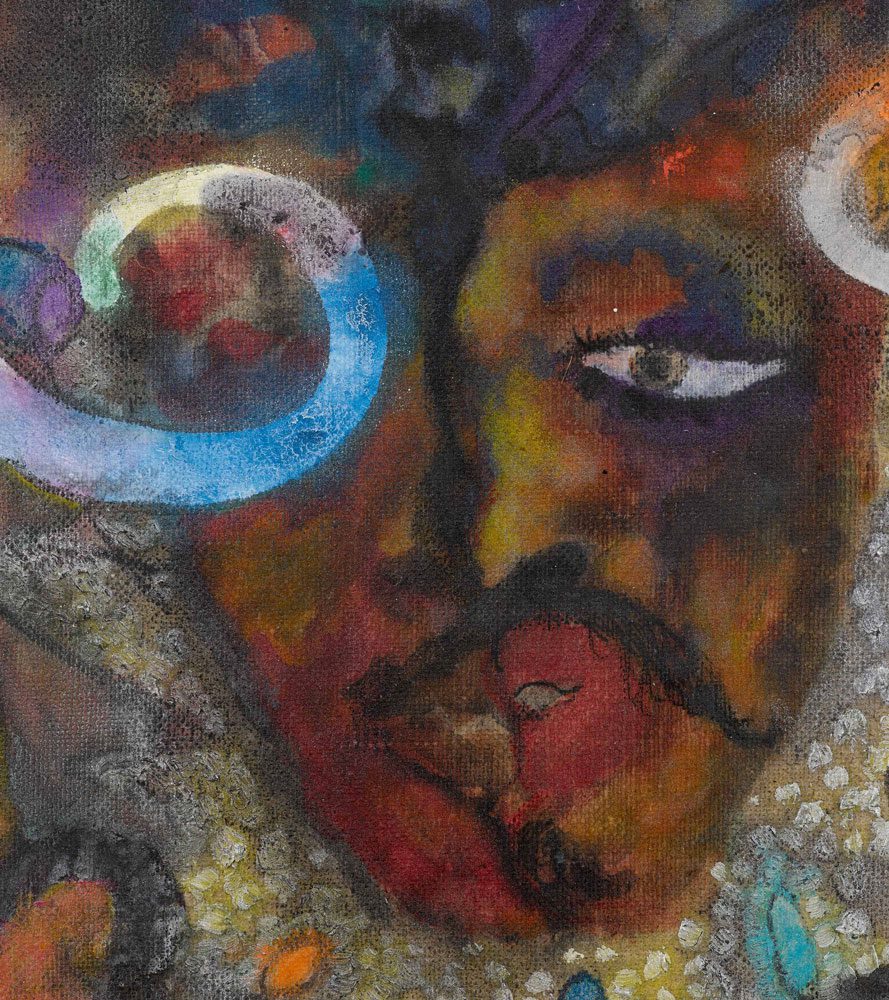PRESENTATION: Chris Ofili
In Chris Ofili’s work painterly and cultural elements (both sacred and profane, personal and political, from high art and popular culture) come together to play on ideas of beauty while carrying messages about black culture, history and exoticism. Ofili came to prominence in the early 1990s with richly orchestrated paintings combining rippling dots of paint, drifts of glitter, collaged images and elephant dung – varnished, often studded with map pins and applied to the picture surface as well as supporting the canvas – a combination of physical elevation and symbolic link to the earth.
By Efi Michalarou
Photo: David Zwirner & Victoria Miro Galleries Archive

“Joyful Sorrow” is a two-site exhibition in Paris and Venice of Chris Ofili’s newest body of work that continues his exploration of Shakespeare’s “Othello”. Renowned for his rich, multilayered paintings, Ofili here expands his engagement with William Shakespeare’s “The Tragedy of Othello, the Moor of Venice” (1603–04). The transmuting colors and forms of the watercolors and paintings in this joint exhibition and book reflect the complex interiority of the character Othello – his vulnerabilities and his joyful sorrows. The artist also considers these works, which investigate ideas of authenticity, meaning, and selfhood, to be partly self-portraits. In encountering these repeated representations of Othello, as viewers and readers, we are asked to consider metamorphosis, love, the bearing of outside influences on our inner selves, and the force we exercise on the world. In Paris the exhibition, comprises a new series of paintings, titled “Othello—Shroud”, which develops the artist’s relationship with William Shakespeare. In Victoria Miro, the artist presents its other constitutive iteration, featuring a series of works on paper titled “Othello—Reflection”, in its Venice gallery from. These exhibitions are commemorated with a joint publication in collaboration with the scholar, poet, and writer Jason Allen-Paisant. Chris Ofili was born the second of four children to parents May and Michael Ofili, who had immigrated to Manchester, from Lagos, Nigeria, several years earlier. Both parents worked at McVitie’s, a manufacturer of biscuits and sweets, and raised their children in a religious household. Chris Ofili and his elder brother, Anthony, younger brother, Francis, and younger sister, Josephine, attended Roman Catholic schools, and the elder siblings were altar boys. Chris Ofili’s Roman Catholic upbringing would later influence his artwork. When Ofili was 11 years old his father left the family and returned to Nigeria. His mother often worked overtime in order to put all four of her children through college. Ofili was originally interested in furniture design, but, after registering for an art foundation course at Tameside College in Ashton-under-Lyne, near Manchester, he discovered a passion for painting. He enrolled at the Chelsea School of Art, London, and graduated with a B.F.A. degree in 1991. Ofili then went on to receive an M.F.A. in 1993 from the Royal College of Art, London. While pursuing his master’s, Ofili attended an international art workshop in Zimbabwe under a British Council scholarship. Afterward he traveled throughout the country, including a visit to Matobo National Park in southwest Zimbabwe. There he encountered prehistoric cave paintings, many of which were made from hundreds of thousands of dots. Elsewhere he saw wildlife and elephant dung, the latter of which he collected and brought back to London. Ofili’s early work was influenced by his trip to Zimbabwe. In “Painting with Shit on It” (1993), for example, Ofili created an abstract composition made from hundreds of painted dots forming concentric circles. The work was punctuated by an off-centre burst of black paint and elephant dung. Meanwhile, two varnished balls of excrement held up the canvas. Ofili later explained his reason for doing this to The New York Times’s art critic Carol Vogel: “It’s a way of raising the paintings up from the ground and giving them a feeling that they’ve come from the earth rather than simply being hung on a wall.” He went on to note that using elephant dung was also a way of bringing the African landscape to the work, highlighting the belief in some cultures in Africa that elephant excrement is sacred, and nodding to modernism by using dung as a found object. By the mid-1990s Ofili had begun layering abstract figures and collages cut from porn magazines on top of dotted backgrounds. In consideration for the Turner Prize, however, Ofili presented the more sombre painting «No Woman, No Cry» (1998). The work, whose title comes from a Bob Marley song, is an abstract portrait of a Black woman in profile. Tears fall from her eyes, and in each one is a photograph of Stephen Lawrence, the Black teenager who was stabbed to death in 1993 in an unprovoked racially motivated attack while he waited for the bus in London. His mother, Doreen Lawrence, campaigned for justice while visibly grieving. An inquiry into her son’s death was opened in 1997, and a report later concluded that the Metropolitan Police’s investigation into the murder was disorderly and marred by institutional racism. Ofili’s tribute to Doreen Lawrence’s sorrow garnered him the Turner Prize and brought him national attention. It was not until 1999, however, that Ofili gained international notoriety. His painting “The Holy Virgin Mary” (1996) caused an outcry when it traveled with the exhibition “Sensation: Young British Artists from the Saatchi Collection” to the Brooklyn Museum. The exhibition showcasing the personal collection of British advertising executive and art collector Charles Saatchi had already sparked controversy when it opened at the Royal College of Art in 1997. The public protested the inclusion of contentious artworks by Tracy Emin, Marcus Harvey, and Damien Hirst, but Ofili’s work had not been singled out during the uproar. In the United States, however, Ofili’s portrayal of the Virgin Mary as a Black woman as well as his use of elephant dung and cutouts of vulvas and buttocks from pornographic magazines led public officials to decry the work as sacrilegious and offensive. New York City Mayor Rudy Giuliani famously attempted to withhold city funding to the museum, while one protester smeared white paint over the artwork. Following the controversy, Ofili stayed out of the spotlight and sought new forms of expression. He worked on several projects with British architect David Adjaye, with whom he had reconnected several years after they had both attended the Royal College of Art. These collaborations included the installations “The Upper Room” (2002) and “Within Reach” (2003), the latter of which was for the British pavilion at the Venice Biennale. In 2005 Ofili moved from London to Port of Spain, Trinidad, with his wife. Inspired by his new home in Trinidad, German Expressionism, and the Bible, Ofili experimented with sculptures and began painting primarily with a blue palette. A few of the works from this blue series, including “Iscariot Blues”, are so dark that they require the viewer’s patience to make out the forms. About the same time Ofili also applied a new approach to painting that was reminiscent of work by Paul Gauguin and Henri Matisse. He incorporated imagery from mythology and literature and used a wider, more vivid colour palette. He expanded his practice in the late 2010s, creating sets and costumes for the Royal Ballet, London, as well as a tapestry, “The Caged Bird’s Song” (2014–17), for the Clothworkers’ Hall, London. In 2017 he began a series of lush paintings based on the seven deadly sins, featuring an electric pastel palette, gleaming painted dots, and abstract black figures, florals, and fauna. He completed the works in 2023 and showed them at the Victoria Miro Gallery, London, that year.
Photo: Chris Ofili, Othello – Shroud, 2023-2024, © Chris Ofili, Courtesy the artist and David Zwirner Gallery
Info: David Zwirner Gallery, 108 rue Vieille du Temple, Paris, France, Duration: 14/10-30/11/2024, Days & Hours: Tue-Sat 11:00-19:00, www.davidzwirner.com/ & Victoria Miro Gallery, San Marco 1994, Calle Drio La Chiesa, Venice, Italy, Duration: 26/10-14/12/2024, Days & Hours: Tue-Sat 10:00-13:00 & 14:00-18:00, www.victoria-miro.com/




